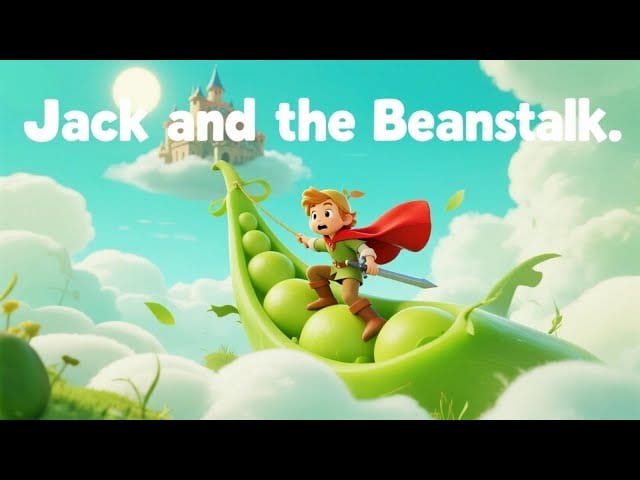The fairy tale of Jack and the Beanstalk has delighted readers and listeners for centuries. A young boy trades his family’s cow for magical beans, climbs a giant beanstalk into the sky, and outwits a fearsome giant. This simple narrative has been retold in countless variations across cultures, with each version reflecting moral lessons about bravery, greed, and resourcefulness.
In this article, we explore the origins, summary, themes, symbolism, and modern adaptations of Jack and the Beanstalk, showing why it continues to hold a firm place in literature, education, and popular imagination.
Origins of Jack and the Beanstalk
The story of Jack and the Beanstalk can be traced back to English folktales of the 18th and 19th centuries.
- Earliest Print Version
The first known published version, titled The History of Jack Spriggins and the Enchanted Bean, appeared in 1734. - Benjamin Tabart’s Version (1807)
One of the earliest detailed literary versions was published by Tabart, who emphasized Jack’s virtue and his mother’s poverty as a reason for his quest. - Joseph Jacobs’ Version (1890)
Jacobs included the tale in his collection English Fairy Tales. This version became the most popular, cementing the phrases and events we know today.
Like many folk stories, Jack and the Beanstalk evolved through oral tradition before reaching written form. Its timeless nature has made it a staple of fairy tale literature.
Little Red Riding Hood: A Timeless Tale of Caution, Courage, and Transformation
Summary of the Story
The classic tale follows a predictable yet thrilling sequence:
- Jack’s Poverty
Jack lives with his widowed mother. They are poor, owning only a cow. - The Trade
His mother sends Jack to sell the cow. Instead, he trades it for magic beans offered by a stranger. - The Beanstalk
Angry, his mother throws the beans out the window. Overnight, a gigantic beanstalk grows, reaching into the clouds. - The Giant’s Castle
Jack climbs the beanstalk and discovers a giant’s castle. Inside, he finds treasures:- A hen that lays golden eggs
- A magical harp that plays by itself
- Bags of gold coins
- The Giant Encounter
Each time Jack sneaks into the castle, the giant senses him and utters the famous chant:
“Fee-fi-fo-fum, I smell the blood of an Englishman.
Be he alive or be he dead, I’ll grind his bones to make my bread!” - The Escape
Jack narrowly escapes the giant’s clutches, returning home with treasures. - The Final Confrontation
On his last visit, Jack steals the harp. The harp cries out, waking the giant. The giant chases Jack down the beanstalk. - The Resolution
Jack chops down the beanstalk with an axe, causing the giant to fall to his death. Jack and his mother live happily ever after with their newfound wealth.

Symbolism in Jack and the Beanstalk
The story’s simple events carry deeper symbolic meaning:
1. The Beanstalk
The towering beanstalk represents opportunity, growth, and the path from childhood to adulthood. It is both a bridge to danger and a road to success.
2. The Giant
The giant symbolizes greed, fear, and oppressive power. He is the obstacle Jack must overcome to achieve independence.
3. The Cow
The cow symbolizes Jack’s family’s only livelihood. Trading it for beans may seem foolish but symbolizes risk-taking in pursuit of something greater.
4. The Magical Objects
- The golden eggs represent wealth and stability.
- The harp represents creativity and culture.
- The gold coins symbolize material prosperity.
5. Jack
Jack embodies curiosity, boldness, and the willingness to take risks. He is both criticized for his recklessness and praised for his bravery.
Themes in Jack and the Beanstalk
- Poverty and Survival
The story begins with Jack and his mother struggling to survive. His quest stems from poverty, making the adventure relatable to common people. - Risk and Reward
Jack takes risks by trading the cow, climbing the beanstalk, and confronting the giant. His daring actions bring rewards, though not without danger. - Cleverness vs. Strength
The tale contrasts Jack’s cleverness with the brute strength of the giant. Intelligence and cunning triumph over size and power. - Coming of Age
Jack matures through his adventures, learning responsibility, courage, and independence. - Justice and Morality
Some versions justify Jack’s theft by portraying the giant as evil and unjust. Others raise questions about whether Jack is right to steal.
Morals of the Story
The morals of Jack and the Beanstalk differ slightly depending on the version but generally include:
- Take risks for greater opportunities — success often requires courage.
- Outwit challenges with intelligence — brains can overcome brawn.
- Use resources wisely — the magical objects symbolize the rewards of cleverness.
- Greed leads to downfall — the giant’s greed and gluttony contribute to his defeat.
- Do not underestimate the powerless — a poor boy defeats a seemingly invincible giant.

Psychological and Literary Interpretations
Scholars and psychologists have read the tale through different lenses:
- Freudian Interpretation: The beanstalk is sometimes viewed as a symbol of growth and ambition, reflecting Jack’s transition into adulthood.
- Jungian Perspective: The giant represents the “shadow” archetype — the darker side of human nature that must be confronted.
- Marxist Reading: The story can be seen as a conflict between the oppressed poor (Jack) and the wealthy ruling class (the giant).
- Moral Dilemma: Some critics argue Jack is a thief, raising questions about whether the end justifies the means.
Variations and Adaptations
The flexibility of the tale has inspired countless retellings.
1. Literature
- Andrew Lang included it in The Red Fairy Book (1890).
- Modern children’s books adapt the tale with illustrations and simplified language.
- Retellings often give Jack more depth or alter the giant’s character.
2. Theatre and Performance
- British pantomimes frequently stage Jack and the Beanstalk, often adding comedy and music.
- Ballets and operas use the story to explore drama and spectacle.
3. Film and Television
- Animated versions by Disney and other studios present family-friendly retellings.
- Movies like Jack the Giant Slayer (2013) adapt the tale into fantasy adventure.
4. Modern Reimaginings
- Authors reinterpret the story through feminist, postmodern, or satirical lenses.
- In some retellings, the giant is portrayed as misunderstood rather than purely evil.
Educational Value
Teachers use Jack and the Beanstalk to introduce children to:
- Narrative structure (beginning, middle, end).
- Character development (Jack’s growth from naive boy to hero).
- Moral lessons (risk-taking, courage, justice).
- Language learning (phrases like “Fee-fi-fo-fum”).
Its combination of action, suspense, and moral dilemmas makes it ideal for classrooms.
Why Jack and the Beanstalk Endures
The enduring popularity of Jack and the Beanstalk can be attributed to several factors:
- Relatable Characters: Jack represents the underdog who overcomes adversity.
- Adventure and Fantasy: A magical beanstalk and giant castle capture the imagination.
- Universal Themes: Poverty, ambition, and courage resonate across cultures.
- Moral Ambiguity: The tension between Jack’s heroism and his theft sparks discussion.
- Adaptability: From children’s bedtime stories to Hollywood blockbusters, the tale fits every medium.
Conclusion
Jack and the Beanstalk is far more than a simple fairy tale. It is a story of transformation, courage, and the complex interplay between morality and survival. From its humble origins in oral tradition to modern adaptations in film and literature, the tale continues to inspire, entertain, and provoke thought.
At its heart lies the universal human desire to rise above adversity. Jack’s climb up the beanstalk is not just a physical ascent but also a symbolic journey of growth. By defeating the giant, Jack shows that even the smallest individuals can overcome great challenges with courage, wit, and determination.
This is why, centuries later, Jack and the Beanstalk remains one of the most beloved and retold stories in the world a true giant of folklore.


